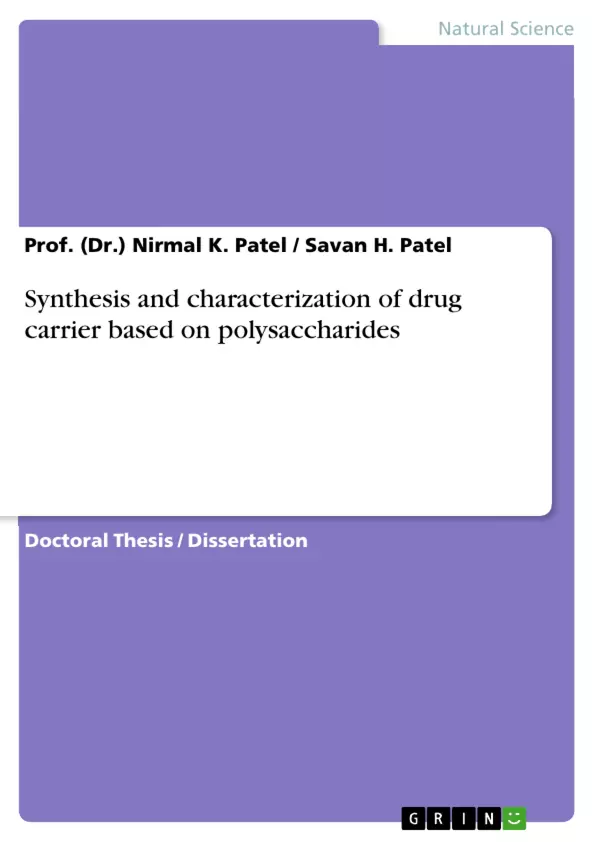The title of this thesis “Synthesis and Characterization of Drug Carrier Based on Polysaccharides” clearly reflects the objective, which is an approach towards preparation of excipients, defined as ‘the substance used as a medium for giving a medicament’, that is to say with simply the functions of an inert support of the active principle or principles.
Okra gum, obtained from the fruits of Hibiscus esculents, is a polysaccharide consisting of D-galactose, L-rhamnose and L-galacturonic acid. It is used as a binder. In studies okra gum has been evaluated as a binder in paracetamol tablet formulations. These formulations containing okra gum as a binder showed a faster onset and higher amount of plastic deformation than those containing gelatin. The crushing strength and disintegration times of the tablets increased with higher binder concentration, while their friability decreased. Although gelatin produced four tablets with higher crushing strength, okra gum produced tablets with longer disintegration times than those containing gelatin. It was finally concluded from the results that okra gum may be a useful hydrophilic matrixing agent in sustained drug delivery system. Various strategies were developed in order to overcome these issues, offering the opportunity to tailor the physical and chemical properties of okra gum thus yielding materials that may find a wide range of applications.
Extraction and purification of okra gum was carried out from okra pods. Followed by carboxymethylated and phosphorylation of extracted okra gum, which was carried out along with optimization of reaction parameter of the primary derivatives that is carboxymethylated okra gum and hydroxyl propyl okra phosphate, followed by drug carriers preparation. By the second modification carboxymethylated okra gum and hydroxyl propyl okra phosphate were carried out by cross linking acrylic acid, N, N-methylene acryl amide, hydroxyethyl methacrylate (HEMA) respectively synthesized cross-linked polymer were further investigated as drug carriers by formulating as tablet for sustained drug release. The drug release of different formulations were measured in relation to time and also compared with the standard drugs. Further mathematical modeling was implemented to know the order of release behavior of formulated tables.
Inhaltsverzeichnis (Table of Contents)
-
Chapter- 1
-
1.0 Introduction
- 1.1 Monosaccharide
- 1.2 Function in biology
- 1.3 Fermentation
- 1.4 A cyclic form of glucose
- 1.5 Production
- 1.6 Polysaccharides
- 1.7 Example of polysaccharide
- 1.8 Plant polysaccharides
- 1.9 Gums and it's classification
- 1.10 What are gums and mucilage's?
- 1.11 Isolation and purification of gums/mucilage's
- 1.12 Reasons for developing new excipients
- 1.13 Modification of existing gums and mucilage's
- 1.14 Purpose of modification
- 1.15 Derivatives of natural gums
- 1.16 Methodological approaches and categorization of polymeric modification techniques
- 1.17 With fenton's reagent (Fe²+ / H2O2)
- 1.18 Cross linking
- 1.19 Conventional pharmacotherapy
- 1.20 Controlled release methods
- 1.21 Time - controlled: modified - release formulation
- 1.22 Controlled distribution
- 1.23 Polymers used for controlled-drug release
- 1.24 Conventional drug therapy
- 1.25 Sustained release formulations
- 1.26 Tablets as a dosage form
- 1.27 Types of tablets
- 1.28 Tablet ingredients
- 1.29 In vitro dissolution testing in pharmaceutical analysis
- 1.30 Dissolution
-
1.0 Introduction
Zielsetzung und Themenschwerpunkte (Objectives and Key Themes)
This work explores the synthesis and characterization of drug carriers based on polysaccharides, focusing on the potential applications in controlled drug delivery systems.
- The properties and functions of monosaccharides and polysaccharides.
- The synthesis and modification of polysaccharide-based drug carriers.
- The evaluation of the drug release characteristics of these carriers.
- The potential applications of these carriers in various drug delivery systems.
- The advantages and disadvantages of using polysaccharides as drug carriers.
Zusammenfassung der Kapitel (Chapter Summaries)
- Chapter- 1: This chapter provides an introduction to monosaccharides and polysaccharides, their structure, function, and various examples. It also explores the production, physical and chemical properties of specific monosaccharides, highlighting the importance of glucose and fructose. The chapter further delves into the structure and functions of polysaccharides, including starch, glycogen, cellulose, and chitin, while introducing natural gums and their classification.
Schlüsselwörter (Keywords)
This work focuses on polysaccharides, drug delivery, controlled release, synthesis, characterization, and pharmaceutical applications. It delves into the properties and modifications of natural gums, exploring their potential as drug carriers and the various advantages and disadvantages associated with their use in this context.
- Quote paper
- Prof. (Dr.) Nirmal K. Patel (Author), Dr. Savan H. Patel (Author), 2022, Synthesis and characterization of drug carrier based on polysaccharides, Munich, GRIN Verlag, https://www.grin.com/document/1311192



